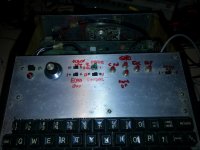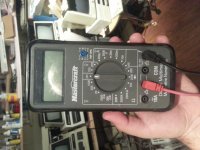Chuck(G)
25k Member
Looking at the display, you have serious hum/AC ripple problems.
The switches that you have don't match anything on mine. You should have momentary contact pushbuttons for clear screen, line, etc.
So let's go back to zero on this.
First off, what shape (and in particular, the +5V output) is your power supply in? How much ripple do you detect?
Second, remember that the keyboard and display sections are completely separate. I assume that you have a UART card in there with an AY-4-1013, S1883 or TR1602 IC on it? It's completely normal for the screen to come up in garbage--there's no power-on preset for the display RAM. You should be able to clear it with the pushbutton that goes to pin 8 on J3. Similarly, you should be able to select which display page you're showing with the switch that grounds either J10 pin 1 or pin 2.
Similarly, the pushbutton that goes to J3, pin 2, is "forward cursor"; to pin 4, "backward cursor"; to pin 1, "home"; to pin 5, "line up"; and to pin 3, "line down". You might want to label them.
A little tip--you can significantly reduce the power consumption of the terminal by replacing the 6-2102 ICs on the display memory board with 21L02 or 91L02 chips. Those old 2102s devices and get pretty hot.
The switches that you have don't match anything on mine. You should have momentary contact pushbuttons for clear screen, line, etc.
So let's go back to zero on this.
First off, what shape (and in particular, the +5V output) is your power supply in? How much ripple do you detect?
Second, remember that the keyboard and display sections are completely separate. I assume that you have a UART card in there with an AY-4-1013, S1883 or TR1602 IC on it? It's completely normal for the screen to come up in garbage--there's no power-on preset for the display RAM. You should be able to clear it with the pushbutton that goes to pin 8 on J3. Similarly, you should be able to select which display page you're showing with the switch that grounds either J10 pin 1 or pin 2.
Similarly, the pushbutton that goes to J3, pin 2, is "forward cursor"; to pin 4, "backward cursor"; to pin 1, "home"; to pin 5, "line up"; and to pin 3, "line down". You might want to label them.
A little tip--you can significantly reduce the power consumption of the terminal by replacing the 6-2102 ICs on the display memory board with 21L02 or 91L02 chips. Those old 2102s devices and get pretty hot.


